Meatpack Case Study: Leadership, Culture, Performance at Meatpack
VerifiedAdded on 2020/06/04
|11
|3746
|238
Case Study
AI Summary
This case study analyzes Meatpack, a food processing company, focusing on the leadership of CEO Derek Bison and his strategies for achieving a $1 billion sales target. The report examines the effectiveness of different leadership approaches (hands-on vs. hands-off) and their impact on organizational culture and performance. It explores the changes in senior leadership, the implementation of a flatter organizational structure, and the barriers to cultural change within the company. The study highlights the importance of leadership development programs, communication strategies, and the need for a clear organizational structure to foster a positive and productive work environment. The analysis provides insights into the challenges faced by Meatpack and suggests recommendations for improving leadership effectiveness and driving business growth. The case study further delves into the importance of accountability, employee training, and the potential conflicts arising from structural changes, offering a comprehensive overview of the company's journey towards its goals.
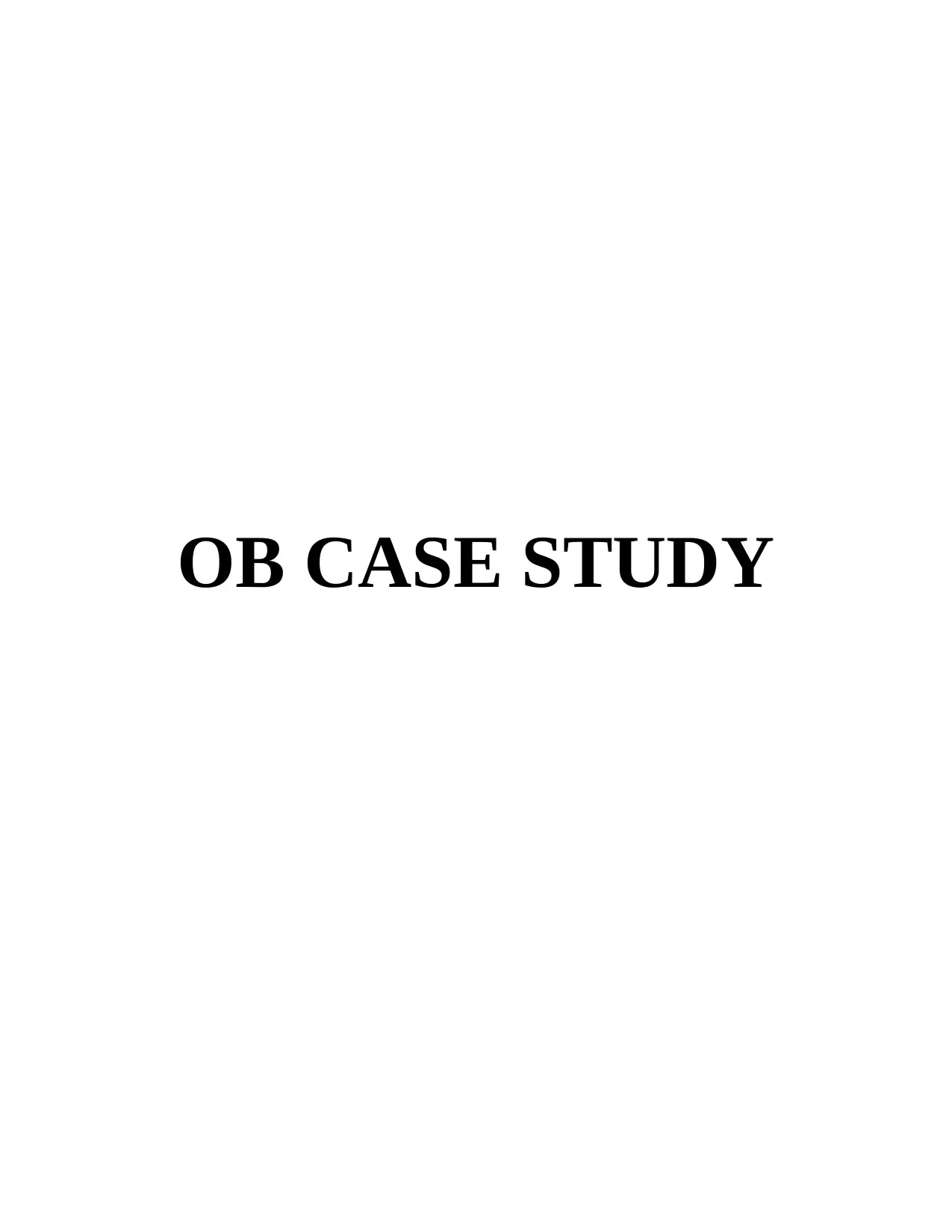
OB CASE STUDY
Paraphrase This Document
Need a fresh take? Get an instant paraphrase of this document with our AI Paraphraser
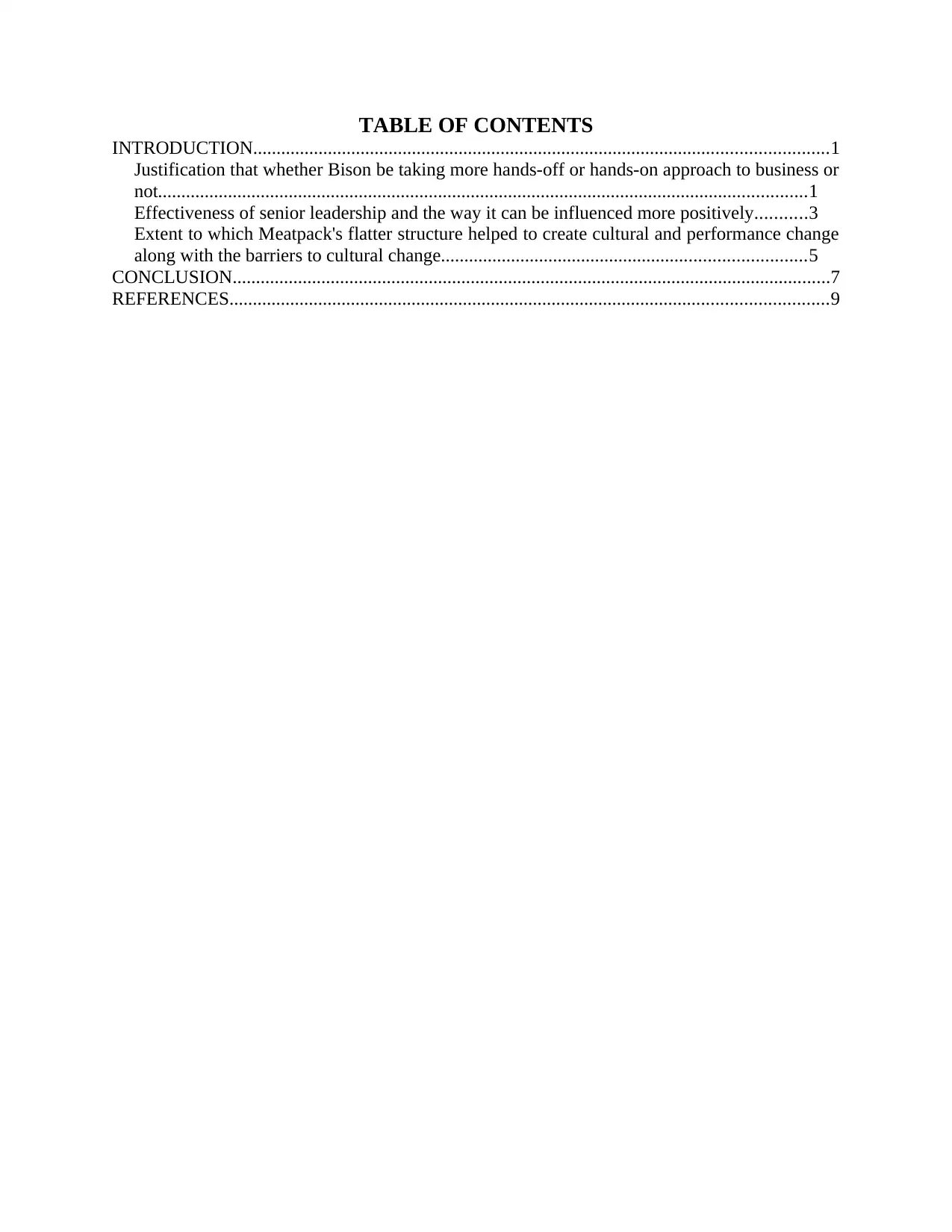
TABLE OF CONTENTS
INTRODUCTION...........................................................................................................................1
Justification that whether Bison be taking more hands-off or hands-on approach to business or
not...........................................................................................................................................1
Effectiveness of senior leadership and the way it can be influenced more positively...........3
Extent to which Meatpack's flatter structure helped to create cultural and performance change
along with the barriers to cultural change..............................................................................5
CONCLUSION................................................................................................................................7
REFERENCES................................................................................................................................9
INTRODUCTION...........................................................................................................................1
Justification that whether Bison be taking more hands-off or hands-on approach to business or
not...........................................................................................................................................1
Effectiveness of senior leadership and the way it can be influenced more positively...........3
Extent to which Meatpack's flatter structure helped to create cultural and performance change
along with the barriers to cultural change..............................................................................5
CONCLUSION................................................................................................................................7
REFERENCES................................................................................................................................9
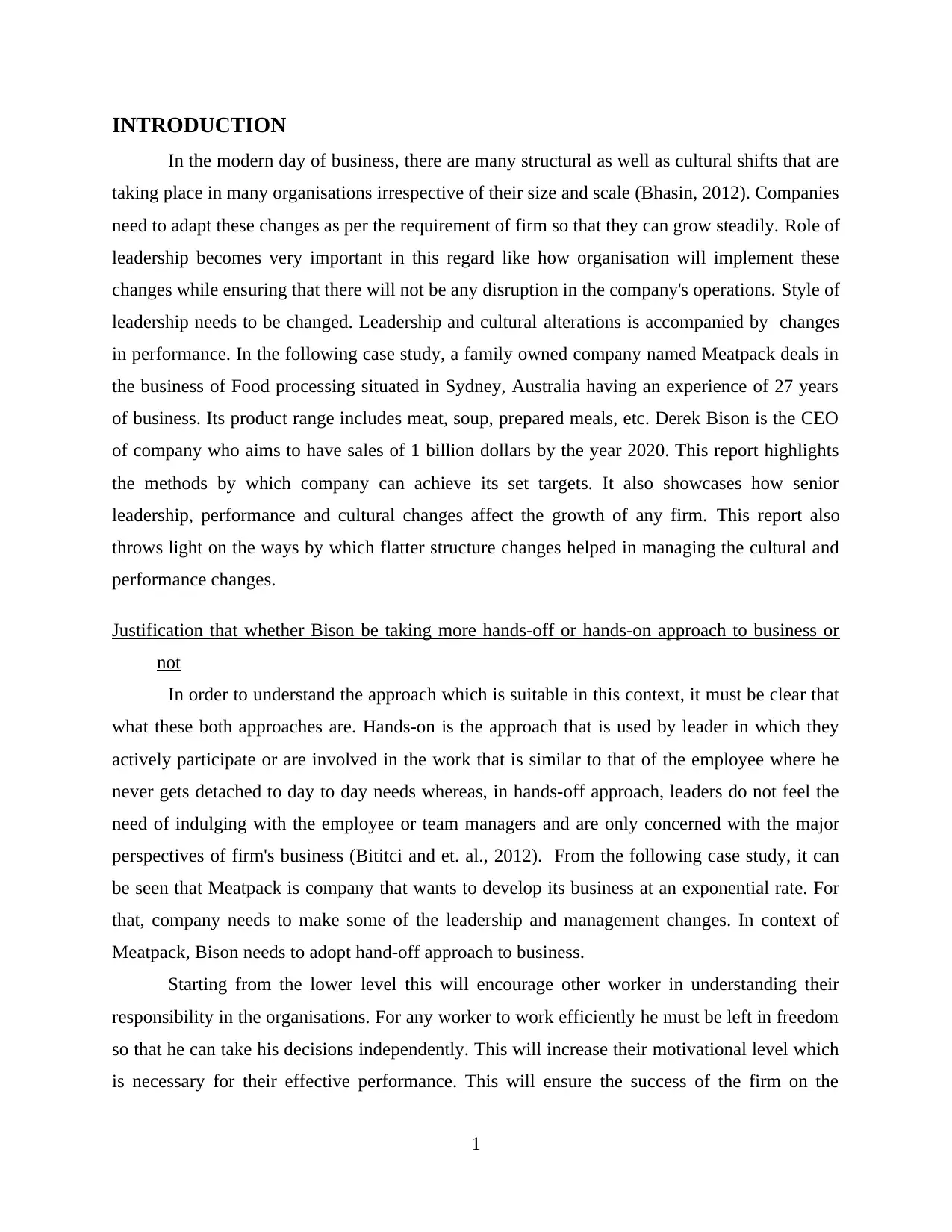
INTRODUCTION
In the modern day of business, there are many structural as well as cultural shifts that are
taking place in many organisations irrespective of their size and scale (Bhasin, 2012). Companies
need to adapt these changes as per the requirement of firm so that they can grow steadily. Role of
leadership becomes very important in this regard like how organisation will implement these
changes while ensuring that there will not be any disruption in the company's operations. Style of
leadership needs to be changed. Leadership and cultural alterations is accompanied by changes
in performance. In the following case study, a family owned company named Meatpack deals in
the business of Food processing situated in Sydney, Australia having an experience of 27 years
of business. Its product range includes meat, soup, prepared meals, etc. Derek Bison is the CEO
of company who aims to have sales of 1 billion dollars by the year 2020. This report highlights
the methods by which company can achieve its set targets. It also showcases how senior
leadership, performance and cultural changes affect the growth of any firm. This report also
throws light on the ways by which flatter structure changes helped in managing the cultural and
performance changes.
Justification that whether Bison be taking more hands-off or hands-on approach to business or
not
In order to understand the approach which is suitable in this context, it must be clear that
what these both approaches are. Hands-on is the approach that is used by leader in which they
actively participate or are involved in the work that is similar to that of the employee where he
never gets detached to day to day needs whereas, in hands-off approach, leaders do not feel the
need of indulging with the employee or team managers and are only concerned with the major
perspectives of firm's business (Bititci and et. al., 2012). From the following case study, it can
be seen that Meatpack is company that wants to develop its business at an exponential rate. For
that, company needs to make some of the leadership and management changes. In context of
Meatpack, Bison needs to adopt hand-off approach to business.
Starting from the lower level this will encourage other worker in understanding their
responsibility in the organisations. For any worker to work efficiently he must be left in freedom
so that he can take his decisions independently. This will increase their motivational level which
is necessary for their effective performance. This will ensure the success of the firm on the
1
In the modern day of business, there are many structural as well as cultural shifts that are
taking place in many organisations irrespective of their size and scale (Bhasin, 2012). Companies
need to adapt these changes as per the requirement of firm so that they can grow steadily. Role of
leadership becomes very important in this regard like how organisation will implement these
changes while ensuring that there will not be any disruption in the company's operations. Style of
leadership needs to be changed. Leadership and cultural alterations is accompanied by changes
in performance. In the following case study, a family owned company named Meatpack deals in
the business of Food processing situated in Sydney, Australia having an experience of 27 years
of business. Its product range includes meat, soup, prepared meals, etc. Derek Bison is the CEO
of company who aims to have sales of 1 billion dollars by the year 2020. This report highlights
the methods by which company can achieve its set targets. It also showcases how senior
leadership, performance and cultural changes affect the growth of any firm. This report also
throws light on the ways by which flatter structure changes helped in managing the cultural and
performance changes.
Justification that whether Bison be taking more hands-off or hands-on approach to business or
not
In order to understand the approach which is suitable in this context, it must be clear that
what these both approaches are. Hands-on is the approach that is used by leader in which they
actively participate or are involved in the work that is similar to that of the employee where he
never gets detached to day to day needs whereas, in hands-off approach, leaders do not feel the
need of indulging with the employee or team managers and are only concerned with the major
perspectives of firm's business (Bititci and et. al., 2012). From the following case study, it can
be seen that Meatpack is company that wants to develop its business at an exponential rate. For
that, company needs to make some of the leadership and management changes. In context of
Meatpack, Bison needs to adopt hand-off approach to business.
Starting from the lower level this will encourage other worker in understanding their
responsibility in the organisations. For any worker to work efficiently he must be left in freedom
so that he can take his decisions independently. This will increase their motivational level which
is necessary for their effective performance. This will ensure the success of the firm on the
1
⊘ This is a preview!⊘
Do you want full access?
Subscribe today to unlock all pages.

Trusted by 1+ million students worldwide
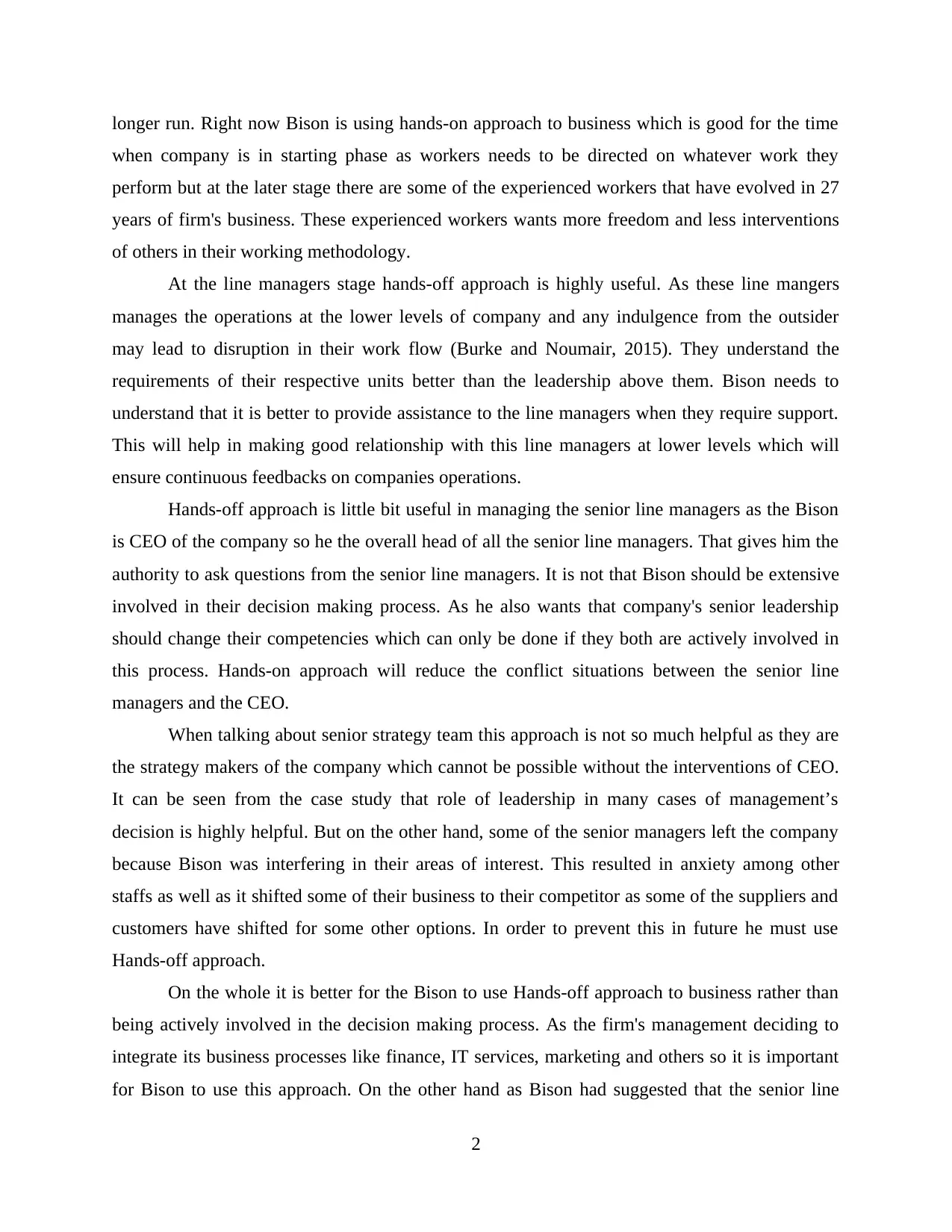
longer run. Right now Bison is using hands-on approach to business which is good for the time
when company is in starting phase as workers needs to be directed on whatever work they
perform but at the later stage there are some of the experienced workers that have evolved in 27
years of firm's business. These experienced workers wants more freedom and less interventions
of others in their working methodology.
At the line managers stage hands-off approach is highly useful. As these line mangers
manages the operations at the lower levels of company and any indulgence from the outsider
may lead to disruption in their work flow (Burke and Noumair, 2015). They understand the
requirements of their respective units better than the leadership above them. Bison needs to
understand that it is better to provide assistance to the line managers when they require support.
This will help in making good relationship with this line managers at lower levels which will
ensure continuous feedbacks on companies operations.
Hands-off approach is little bit useful in managing the senior line managers as the Bison
is CEO of the company so he the overall head of all the senior line managers. That gives him the
authority to ask questions from the senior line managers. It is not that Bison should be extensive
involved in their decision making process. As he also wants that company's senior leadership
should change their competencies which can only be done if they both are actively involved in
this process. Hands-on approach will reduce the conflict situations between the senior line
managers and the CEO.
When talking about senior strategy team this approach is not so much helpful as they are
the strategy makers of the company which cannot be possible without the interventions of CEO.
It can be seen from the case study that role of leadership in many cases of management’s
decision is highly helpful. But on the other hand, some of the senior managers left the company
because Bison was interfering in their areas of interest. This resulted in anxiety among other
staffs as well as it shifted some of their business to their competitor as some of the suppliers and
customers have shifted for some other options. In order to prevent this in future he must use
Hands-off approach.
On the whole it is better for the Bison to use Hands-off approach to business rather than
being actively involved in the decision making process. As the firm's management deciding to
integrate its business processes like finance, IT services, marketing and others so it is important
for Bison to use this approach. On the other hand as Bison had suggested that the senior line
2
when company is in starting phase as workers needs to be directed on whatever work they
perform but at the later stage there are some of the experienced workers that have evolved in 27
years of firm's business. These experienced workers wants more freedom and less interventions
of others in their working methodology.
At the line managers stage hands-off approach is highly useful. As these line mangers
manages the operations at the lower levels of company and any indulgence from the outsider
may lead to disruption in their work flow (Burke and Noumair, 2015). They understand the
requirements of their respective units better than the leadership above them. Bison needs to
understand that it is better to provide assistance to the line managers when they require support.
This will help in making good relationship with this line managers at lower levels which will
ensure continuous feedbacks on companies operations.
Hands-off approach is little bit useful in managing the senior line managers as the Bison
is CEO of the company so he the overall head of all the senior line managers. That gives him the
authority to ask questions from the senior line managers. It is not that Bison should be extensive
involved in their decision making process. As he also wants that company's senior leadership
should change their competencies which can only be done if they both are actively involved in
this process. Hands-on approach will reduce the conflict situations between the senior line
managers and the CEO.
When talking about senior strategy team this approach is not so much helpful as they are
the strategy makers of the company which cannot be possible without the interventions of CEO.
It can be seen from the case study that role of leadership in many cases of management’s
decision is highly helpful. But on the other hand, some of the senior managers left the company
because Bison was interfering in their areas of interest. This resulted in anxiety among other
staffs as well as it shifted some of their business to their competitor as some of the suppliers and
customers have shifted for some other options. In order to prevent this in future he must use
Hands-off approach.
On the whole it is better for the Bison to use Hands-off approach to business rather than
being actively involved in the decision making process. As the firm's management deciding to
integrate its business processes like finance, IT services, marketing and others so it is important
for Bison to use this approach. On the other hand as Bison had suggested that the senior line
2
Paraphrase This Document
Need a fresh take? Get an instant paraphrase of this document with our AI Paraphraser
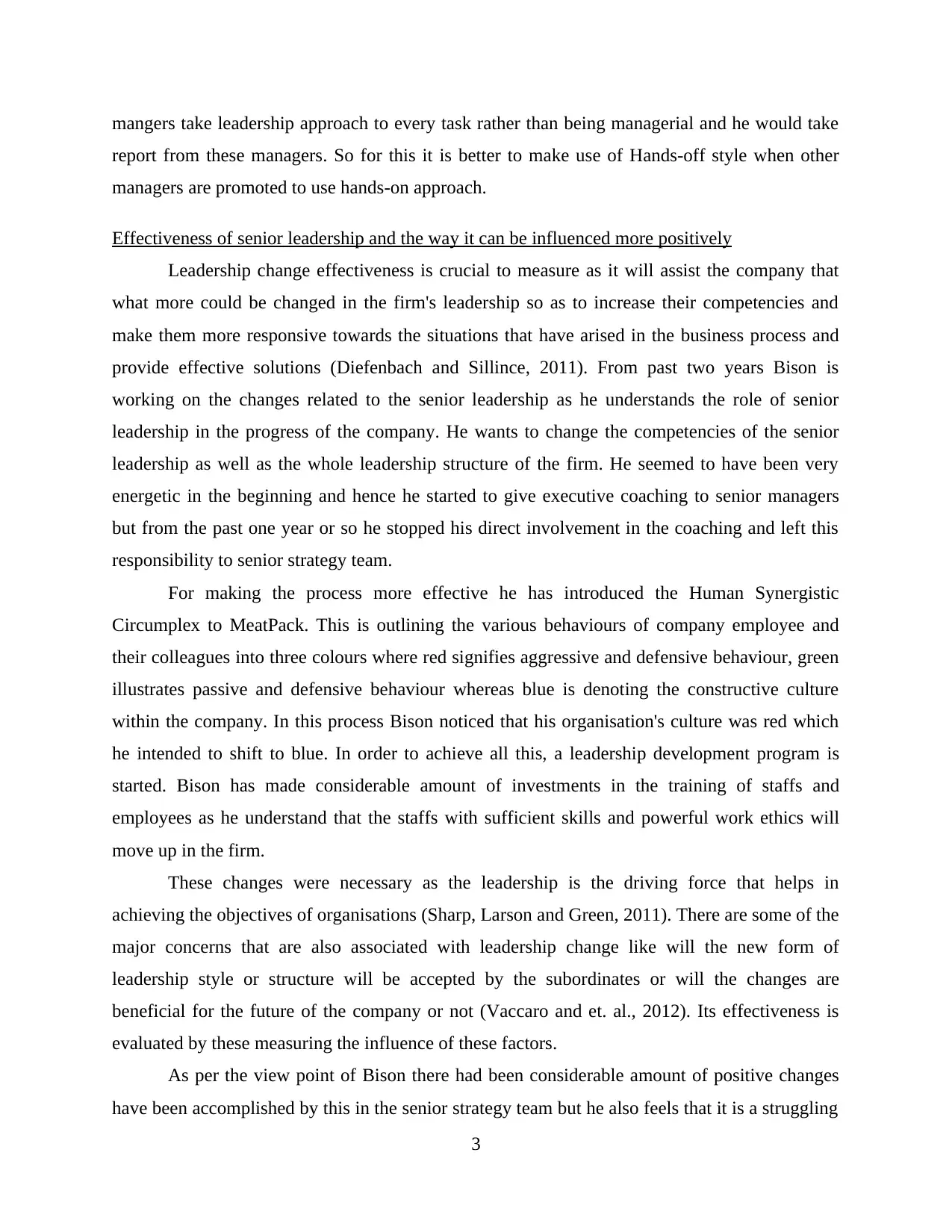
mangers take leadership approach to every task rather than being managerial and he would take
report from these managers. So for this it is better to make use of Hands-off style when other
managers are promoted to use hands-on approach.
Effectiveness of senior leadership and the way it can be influenced more positively
Leadership change effectiveness is crucial to measure as it will assist the company that
what more could be changed in the firm's leadership so as to increase their competencies and
make them more responsive towards the situations that have arised in the business process and
provide effective solutions (Diefenbach and Sillince, 2011). From past two years Bison is
working on the changes related to the senior leadership as he understands the role of senior
leadership in the progress of the company. He wants to change the competencies of the senior
leadership as well as the whole leadership structure of the firm. He seemed to have been very
energetic in the beginning and hence he started to give executive coaching to senior managers
but from the past one year or so he stopped his direct involvement in the coaching and left this
responsibility to senior strategy team.
For making the process more effective he has introduced the Human Synergistic
Circumplex to MeatPack. This is outlining the various behaviours of company employee and
their colleagues into three colours where red signifies aggressive and defensive behaviour, green
illustrates passive and defensive behaviour whereas blue is denoting the constructive culture
within the company. In this process Bison noticed that his organisation's culture was red which
he intended to shift to blue. In order to achieve all this, a leadership development program is
started. Bison has made considerable amount of investments in the training of staffs and
employees as he understand that the staffs with sufficient skills and powerful work ethics will
move up in the firm.
These changes were necessary as the leadership is the driving force that helps in
achieving the objectives of organisations (Sharp, Larson and Green, 2011). There are some of the
major concerns that are also associated with leadership change like will the new form of
leadership style or structure will be accepted by the subordinates or will the changes are
beneficial for the future of the company or not (Vaccaro and et. al., 2012). Its effectiveness is
evaluated by these measuring the influence of these factors.
As per the view point of Bison there had been considerable amount of positive changes
have been accomplished by this in the senior strategy team but he also feels that it is a struggling
3
report from these managers. So for this it is better to make use of Hands-off style when other
managers are promoted to use hands-on approach.
Effectiveness of senior leadership and the way it can be influenced more positively
Leadership change effectiveness is crucial to measure as it will assist the company that
what more could be changed in the firm's leadership so as to increase their competencies and
make them more responsive towards the situations that have arised in the business process and
provide effective solutions (Diefenbach and Sillince, 2011). From past two years Bison is
working on the changes related to the senior leadership as he understands the role of senior
leadership in the progress of the company. He wants to change the competencies of the senior
leadership as well as the whole leadership structure of the firm. He seemed to have been very
energetic in the beginning and hence he started to give executive coaching to senior managers
but from the past one year or so he stopped his direct involvement in the coaching and left this
responsibility to senior strategy team.
For making the process more effective he has introduced the Human Synergistic
Circumplex to MeatPack. This is outlining the various behaviours of company employee and
their colleagues into three colours where red signifies aggressive and defensive behaviour, green
illustrates passive and defensive behaviour whereas blue is denoting the constructive culture
within the company. In this process Bison noticed that his organisation's culture was red which
he intended to shift to blue. In order to achieve all this, a leadership development program is
started. Bison has made considerable amount of investments in the training of staffs and
employees as he understand that the staffs with sufficient skills and powerful work ethics will
move up in the firm.
These changes were necessary as the leadership is the driving force that helps in
achieving the objectives of organisations (Sharp, Larson and Green, 2011). There are some of the
major concerns that are also associated with leadership change like will the new form of
leadership style or structure will be accepted by the subordinates or will the changes are
beneficial for the future of the company or not (Vaccaro and et. al., 2012). Its effectiveness is
evaluated by these measuring the influence of these factors.
As per the view point of Bison there had been considerable amount of positive changes
have been accomplished by this in the senior strategy team but he also feels that it is a struggling
3
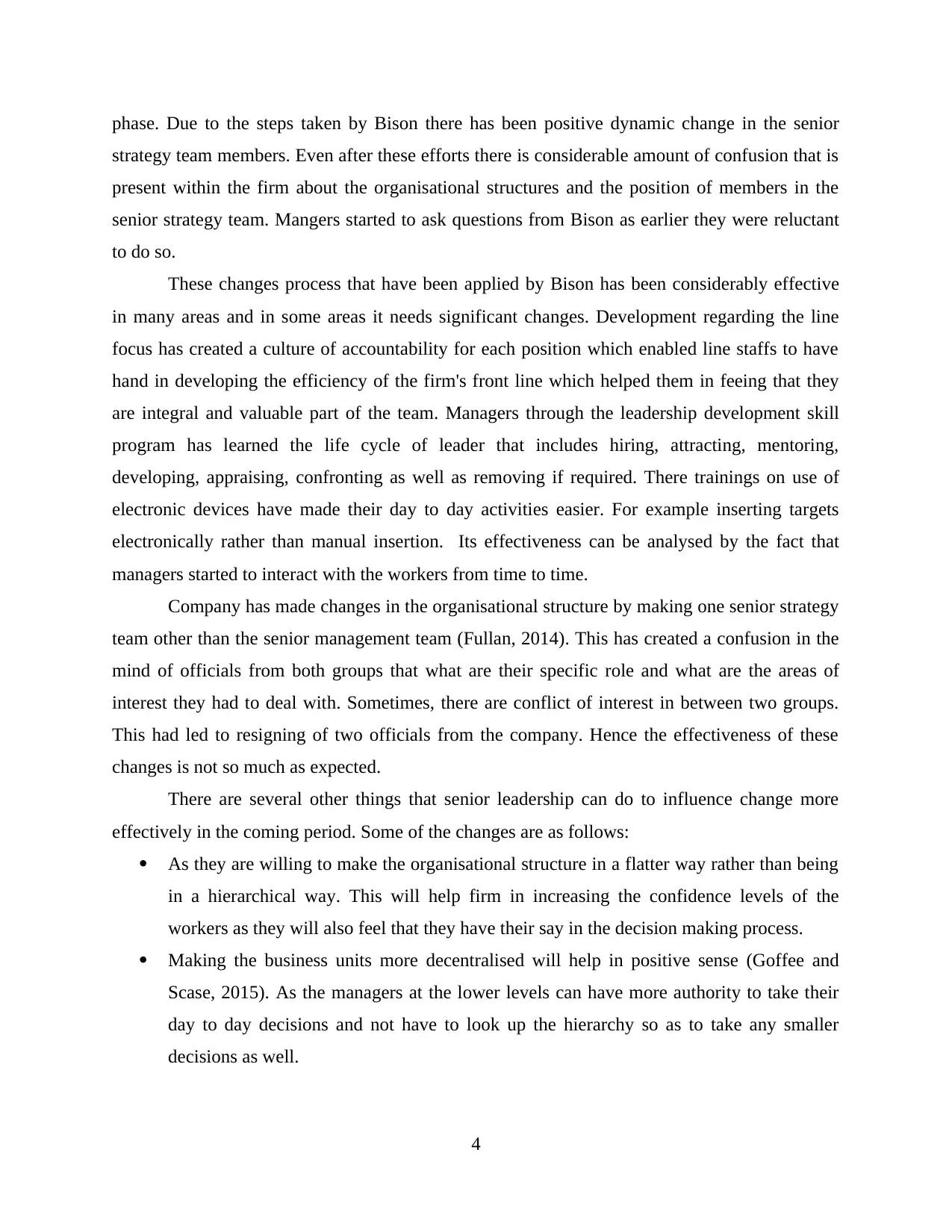
phase. Due to the steps taken by Bison there has been positive dynamic change in the senior
strategy team members. Even after these efforts there is considerable amount of confusion that is
present within the firm about the organisational structures and the position of members in the
senior strategy team. Mangers started to ask questions from Bison as earlier they were reluctant
to do so.
These changes process that have been applied by Bison has been considerably effective
in many areas and in some areas it needs significant changes. Development regarding the line
focus has created a culture of accountability for each position which enabled line staffs to have
hand in developing the efficiency of the firm's front line which helped them in feeing that they
are integral and valuable part of the team. Managers through the leadership development skill
program has learned the life cycle of leader that includes hiring, attracting, mentoring,
developing, appraising, confronting as well as removing if required. There trainings on use of
electronic devices have made their day to day activities easier. For example inserting targets
electronically rather than manual insertion. Its effectiveness can be analysed by the fact that
managers started to interact with the workers from time to time.
Company has made changes in the organisational structure by making one senior strategy
team other than the senior management team (Fullan, 2014). This has created a confusion in the
mind of officials from both groups that what are their specific role and what are the areas of
interest they had to deal with. Sometimes, there are conflict of interest in between two groups.
This had led to resigning of two officials from the company. Hence the effectiveness of these
changes is not so much as expected.
There are several other things that senior leadership can do to influence change more
effectively in the coming period. Some of the changes are as follows:
As they are willing to make the organisational structure in a flatter way rather than being
in a hierarchical way. This will help firm in increasing the confidence levels of the
workers as they will also feel that they have their say in the decision making process.
Making the business units more decentralised will help in positive sense (Goffee and
Scase, 2015). As the managers at the lower levels can have more authority to take their
day to day decisions and not have to look up the hierarchy so as to take any smaller
decisions as well.
4
strategy team members. Even after these efforts there is considerable amount of confusion that is
present within the firm about the organisational structures and the position of members in the
senior strategy team. Mangers started to ask questions from Bison as earlier they were reluctant
to do so.
These changes process that have been applied by Bison has been considerably effective
in many areas and in some areas it needs significant changes. Development regarding the line
focus has created a culture of accountability for each position which enabled line staffs to have
hand in developing the efficiency of the firm's front line which helped them in feeing that they
are integral and valuable part of the team. Managers through the leadership development skill
program has learned the life cycle of leader that includes hiring, attracting, mentoring,
developing, appraising, confronting as well as removing if required. There trainings on use of
electronic devices have made their day to day activities easier. For example inserting targets
electronically rather than manual insertion. Its effectiveness can be analysed by the fact that
managers started to interact with the workers from time to time.
Company has made changes in the organisational structure by making one senior strategy
team other than the senior management team (Fullan, 2014). This has created a confusion in the
mind of officials from both groups that what are their specific role and what are the areas of
interest they had to deal with. Sometimes, there are conflict of interest in between two groups.
This had led to resigning of two officials from the company. Hence the effectiveness of these
changes is not so much as expected.
There are several other things that senior leadership can do to influence change more
effectively in the coming period. Some of the changes are as follows:
As they are willing to make the organisational structure in a flatter way rather than being
in a hierarchical way. This will help firm in increasing the confidence levels of the
workers as they will also feel that they have their say in the decision making process.
Making the business units more decentralised will help in positive sense (Goffee and
Scase, 2015). As the managers at the lower levels can have more authority to take their
day to day decisions and not have to look up the hierarchy so as to take any smaller
decisions as well.
4
⊘ This is a preview!⊘
Do you want full access?
Subscribe today to unlock all pages.

Trusted by 1+ million students worldwide
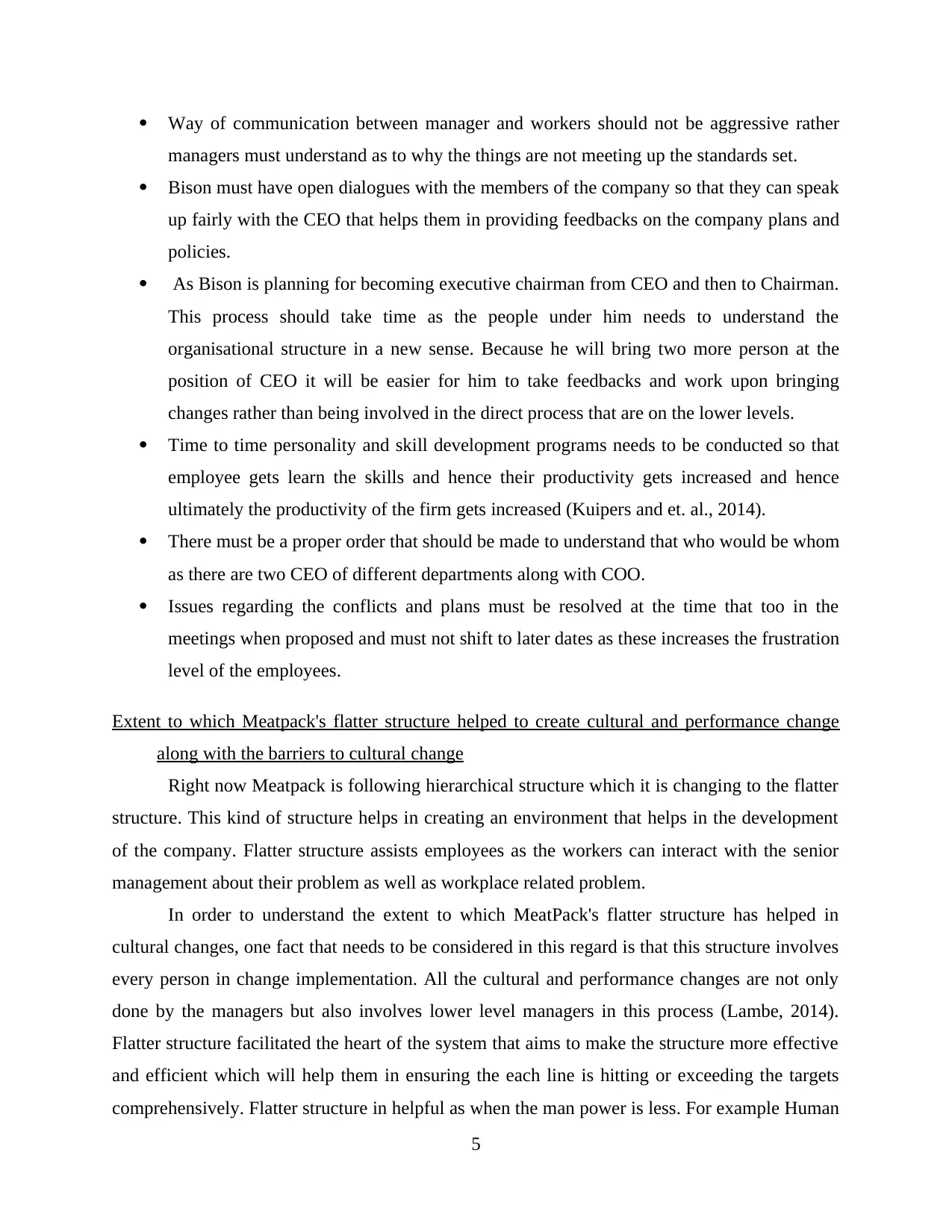
Way of communication between manager and workers should not be aggressive rather
managers must understand as to why the things are not meeting up the standards set.
Bison must have open dialogues with the members of the company so that they can speak
up fairly with the CEO that helps them in providing feedbacks on the company plans and
policies.
As Bison is planning for becoming executive chairman from CEO and then to Chairman.
This process should take time as the people under him needs to understand the
organisational structure in a new sense. Because he will bring two more person at the
position of CEO it will be easier for him to take feedbacks and work upon bringing
changes rather than being involved in the direct process that are on the lower levels.
Time to time personality and skill development programs needs to be conducted so that
employee gets learn the skills and hence their productivity gets increased and hence
ultimately the productivity of the firm gets increased (Kuipers and et. al., 2014).
There must be a proper order that should be made to understand that who would be whom
as there are two CEO of different departments along with COO.
Issues regarding the conflicts and plans must be resolved at the time that too in the
meetings when proposed and must not shift to later dates as these increases the frustration
level of the employees.
Extent to which Meatpack's flatter structure helped to create cultural and performance change
along with the barriers to cultural change
Right now Meatpack is following hierarchical structure which it is changing to the flatter
structure. This kind of structure helps in creating an environment that helps in the development
of the company. Flatter structure assists employees as the workers can interact with the senior
management about their problem as well as workplace related problem.
In order to understand the extent to which MeatPack's flatter structure has helped in
cultural changes, one fact that needs to be considered in this regard is that this structure involves
every person in change implementation. All the cultural and performance changes are not only
done by the managers but also involves lower level managers in this process (Lambe, 2014).
Flatter structure facilitated the heart of the system that aims to make the structure more effective
and efficient which will help them in ensuring the each line is hitting or exceeding the targets
comprehensively. Flatter structure in helpful as when the man power is less. For example Human
5
managers must understand as to why the things are not meeting up the standards set.
Bison must have open dialogues with the members of the company so that they can speak
up fairly with the CEO that helps them in providing feedbacks on the company plans and
policies.
As Bison is planning for becoming executive chairman from CEO and then to Chairman.
This process should take time as the people under him needs to understand the
organisational structure in a new sense. Because he will bring two more person at the
position of CEO it will be easier for him to take feedbacks and work upon bringing
changes rather than being involved in the direct process that are on the lower levels.
Time to time personality and skill development programs needs to be conducted so that
employee gets learn the skills and hence their productivity gets increased and hence
ultimately the productivity of the firm gets increased (Kuipers and et. al., 2014).
There must be a proper order that should be made to understand that who would be whom
as there are two CEO of different departments along with COO.
Issues regarding the conflicts and plans must be resolved at the time that too in the
meetings when proposed and must not shift to later dates as these increases the frustration
level of the employees.
Extent to which Meatpack's flatter structure helped to create cultural and performance change
along with the barriers to cultural change
Right now Meatpack is following hierarchical structure which it is changing to the flatter
structure. This kind of structure helps in creating an environment that helps in the development
of the company. Flatter structure assists employees as the workers can interact with the senior
management about their problem as well as workplace related problem.
In order to understand the extent to which MeatPack's flatter structure has helped in
cultural changes, one fact that needs to be considered in this regard is that this structure involves
every person in change implementation. All the cultural and performance changes are not only
done by the managers but also involves lower level managers in this process (Lambe, 2014).
Flatter structure facilitated the heart of the system that aims to make the structure more effective
and efficient which will help them in ensuring the each line is hitting or exceeding the targets
comprehensively. Flatter structure in helpful as when the man power is less. For example Human
5
Paraphrase This Document
Need a fresh take? Get an instant paraphrase of this document with our AI Paraphraser
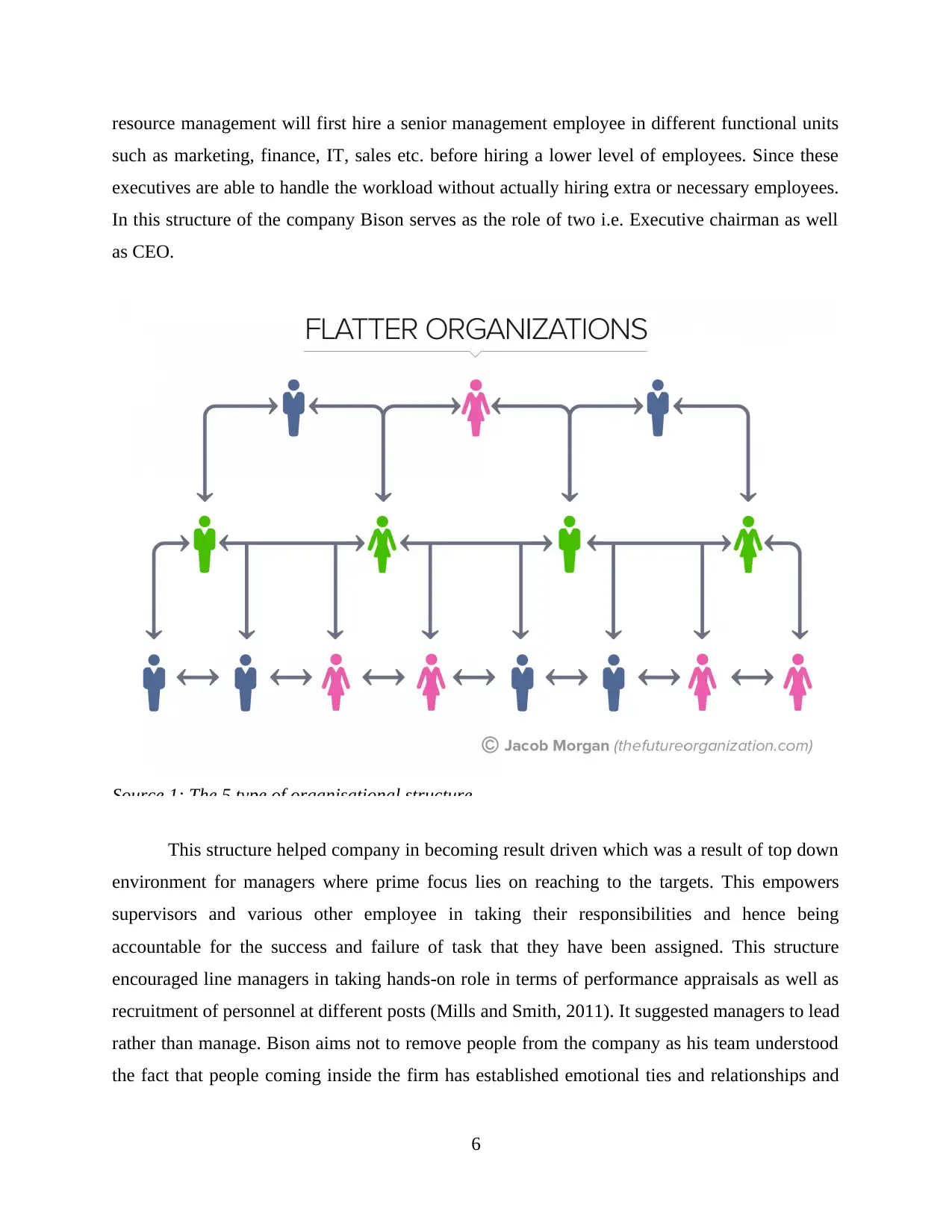
resource management will first hire a senior management employee in different functional units
such as marketing, finance, IT, sales etc. before hiring a lower level of employees. Since these
executives are able to handle the workload without actually hiring extra or necessary employees.
In this structure of the company Bison serves as the role of two i.e. Executive chairman as well
as CEO.
This structure helped company in becoming result driven which was a result of top down
environment for managers where prime focus lies on reaching to the targets. This empowers
supervisors and various other employee in taking their responsibilities and hence being
accountable for the success and failure of task that they have been assigned. This structure
encouraged line managers in taking hands-on role in terms of performance appraisals as well as
recruitment of personnel at different posts (Mills and Smith, 2011). It suggested managers to lead
rather than manage. Bison aims not to remove people from the company as his team understood
the fact that people coming inside the firm has established emotional ties and relationships and
6
Source 1: The 5 type of organisational structure
such as marketing, finance, IT, sales etc. before hiring a lower level of employees. Since these
executives are able to handle the workload without actually hiring extra or necessary employees.
In this structure of the company Bison serves as the role of two i.e. Executive chairman as well
as CEO.
This structure helped company in becoming result driven which was a result of top down
environment for managers where prime focus lies on reaching to the targets. This empowers
supervisors and various other employee in taking their responsibilities and hence being
accountable for the success and failure of task that they have been assigned. This structure
encouraged line managers in taking hands-on role in terms of performance appraisals as well as
recruitment of personnel at different posts (Mills and Smith, 2011). It suggested managers to lead
rather than manage. Bison aims not to remove people from the company as his team understood
the fact that people coming inside the firm has established emotional ties and relationships and
6
Source 1: The 5 type of organisational structure
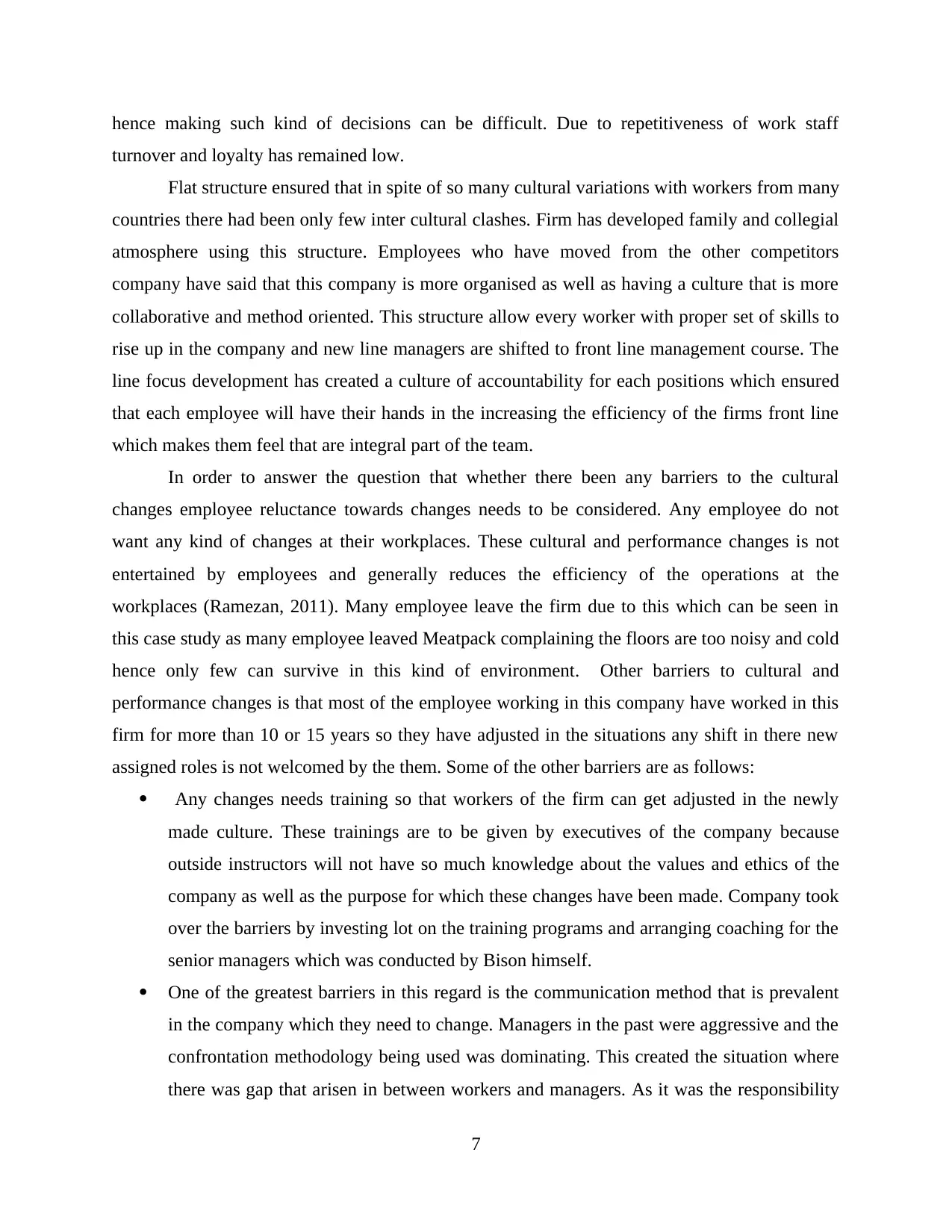
hence making such kind of decisions can be difficult. Due to repetitiveness of work staff
turnover and loyalty has remained low.
Flat structure ensured that in spite of so many cultural variations with workers from many
countries there had been only few inter cultural clashes. Firm has developed family and collegial
atmosphere using this structure. Employees who have moved from the other competitors
company have said that this company is more organised as well as having a culture that is more
collaborative and method oriented. This structure allow every worker with proper set of skills to
rise up in the company and new line managers are shifted to front line management course. The
line focus development has created a culture of accountability for each positions which ensured
that each employee will have their hands in the increasing the efficiency of the firms front line
which makes them feel that are integral part of the team.
In order to answer the question that whether there been any barriers to the cultural
changes employee reluctance towards changes needs to be considered. Any employee do not
want any kind of changes at their workplaces. These cultural and performance changes is not
entertained by employees and generally reduces the efficiency of the operations at the
workplaces (Ramezan, 2011). Many employee leave the firm due to this which can be seen in
this case study as many employee leaved Meatpack complaining the floors are too noisy and cold
hence only few can survive in this kind of environment. Other barriers to cultural and
performance changes is that most of the employee working in this company have worked in this
firm for more than 10 or 15 years so they have adjusted in the situations any shift in there new
assigned roles is not welcomed by the them. Some of the other barriers are as follows:
Any changes needs training so that workers of the firm can get adjusted in the newly
made culture. These trainings are to be given by executives of the company because
outside instructors will not have so much knowledge about the values and ethics of the
company as well as the purpose for which these changes have been made. Company took
over the barriers by investing lot on the training programs and arranging coaching for the
senior managers which was conducted by Bison himself.
One of the greatest barriers in this regard is the communication method that is prevalent
in the company which they need to change. Managers in the past were aggressive and the
confrontation methodology being used was dominating. This created the situation where
there was gap that arisen in between workers and managers. As it was the responsibility
7
turnover and loyalty has remained low.
Flat structure ensured that in spite of so many cultural variations with workers from many
countries there had been only few inter cultural clashes. Firm has developed family and collegial
atmosphere using this structure. Employees who have moved from the other competitors
company have said that this company is more organised as well as having a culture that is more
collaborative and method oriented. This structure allow every worker with proper set of skills to
rise up in the company and new line managers are shifted to front line management course. The
line focus development has created a culture of accountability for each positions which ensured
that each employee will have their hands in the increasing the efficiency of the firms front line
which makes them feel that are integral part of the team.
In order to answer the question that whether there been any barriers to the cultural
changes employee reluctance towards changes needs to be considered. Any employee do not
want any kind of changes at their workplaces. These cultural and performance changes is not
entertained by employees and generally reduces the efficiency of the operations at the
workplaces (Ramezan, 2011). Many employee leave the firm due to this which can be seen in
this case study as many employee leaved Meatpack complaining the floors are too noisy and cold
hence only few can survive in this kind of environment. Other barriers to cultural and
performance changes is that most of the employee working in this company have worked in this
firm for more than 10 or 15 years so they have adjusted in the situations any shift in there new
assigned roles is not welcomed by the them. Some of the other barriers are as follows:
Any changes needs training so that workers of the firm can get adjusted in the newly
made culture. These trainings are to be given by executives of the company because
outside instructors will not have so much knowledge about the values and ethics of the
company as well as the purpose for which these changes have been made. Company took
over the barriers by investing lot on the training programs and arranging coaching for the
senior managers which was conducted by Bison himself.
One of the greatest barriers in this regard is the communication method that is prevalent
in the company which they need to change. Managers in the past were aggressive and the
confrontation methodology being used was dominating. This created the situation where
there was gap that arisen in between workers and managers. As it was the responsibility
7
⊘ This is a preview!⊘
Do you want full access?
Subscribe today to unlock all pages.

Trusted by 1+ million students worldwide
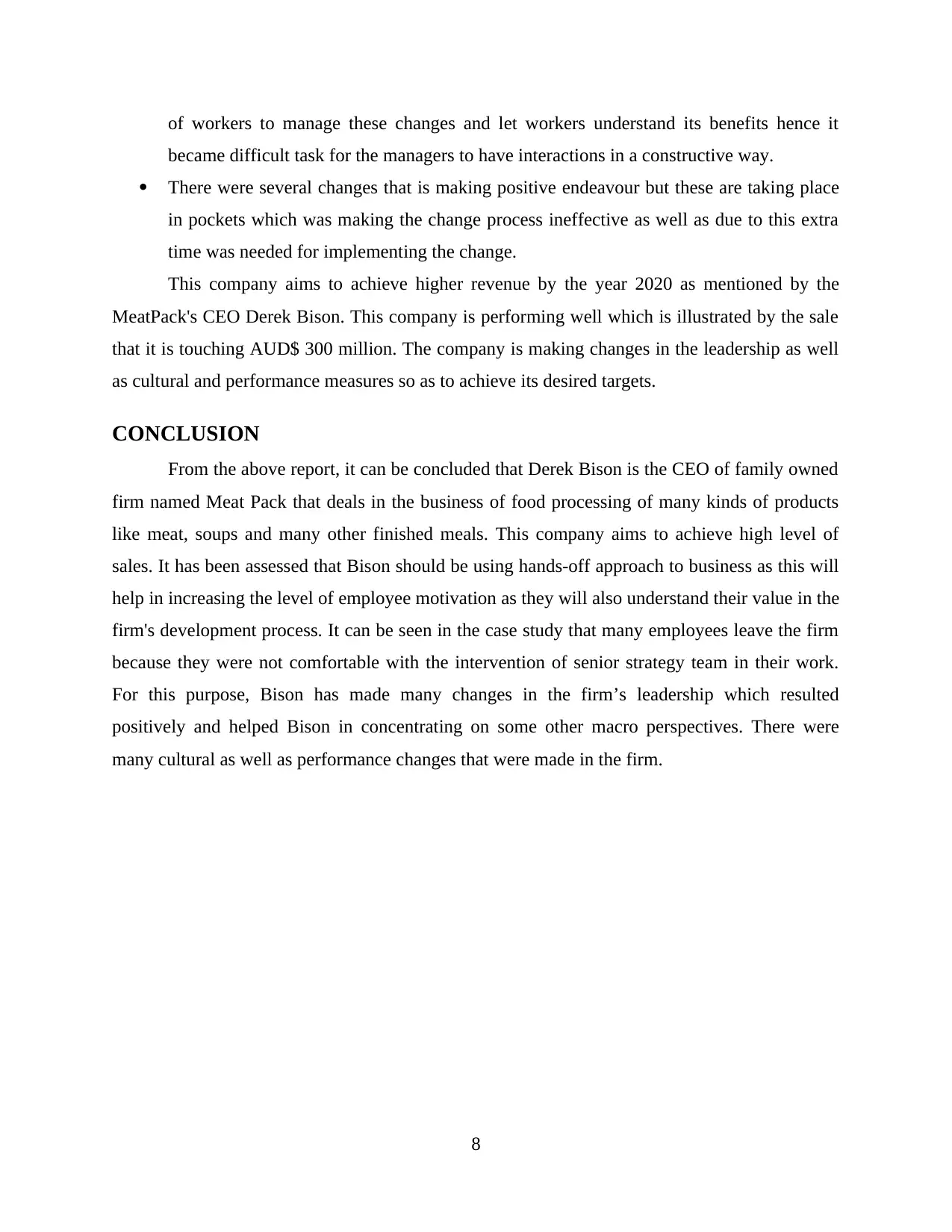
of workers to manage these changes and let workers understand its benefits hence it
became difficult task for the managers to have interactions in a constructive way.
There were several changes that is making positive endeavour but these are taking place
in pockets which was making the change process ineffective as well as due to this extra
time was needed for implementing the change.
This company aims to achieve higher revenue by the year 2020 as mentioned by the
MeatPack's CEO Derek Bison. This company is performing well which is illustrated by the sale
that it is touching AUD$ 300 million. The company is making changes in the leadership as well
as cultural and performance measures so as to achieve its desired targets.
CONCLUSION
From the above report, it can be concluded that Derek Bison is the CEO of family owned
firm named Meat Pack that deals in the business of food processing of many kinds of products
like meat, soups and many other finished meals. This company aims to achieve high level of
sales. It has been assessed that Bison should be using hands-off approach to business as this will
help in increasing the level of employee motivation as they will also understand their value in the
firm's development process. It can be seen in the case study that many employees leave the firm
because they were not comfortable with the intervention of senior strategy team in their work.
For this purpose, Bison has made many changes in the firm’s leadership which resulted
positively and helped Bison in concentrating on some other macro perspectives. There were
many cultural as well as performance changes that were made in the firm.
8
became difficult task for the managers to have interactions in a constructive way.
There were several changes that is making positive endeavour but these are taking place
in pockets which was making the change process ineffective as well as due to this extra
time was needed for implementing the change.
This company aims to achieve higher revenue by the year 2020 as mentioned by the
MeatPack's CEO Derek Bison. This company is performing well which is illustrated by the sale
that it is touching AUD$ 300 million. The company is making changes in the leadership as well
as cultural and performance measures so as to achieve its desired targets.
CONCLUSION
From the above report, it can be concluded that Derek Bison is the CEO of family owned
firm named Meat Pack that deals in the business of food processing of many kinds of products
like meat, soups and many other finished meals. This company aims to achieve high level of
sales. It has been assessed that Bison should be using hands-off approach to business as this will
help in increasing the level of employee motivation as they will also understand their value in the
firm's development process. It can be seen in the case study that many employees leave the firm
because they were not comfortable with the intervention of senior strategy team in their work.
For this purpose, Bison has made many changes in the firm’s leadership which resulted
positively and helped Bison in concentrating on some other macro perspectives. There were
many cultural as well as performance changes that were made in the firm.
8
Paraphrase This Document
Need a fresh take? Get an instant paraphrase of this document with our AI Paraphraser
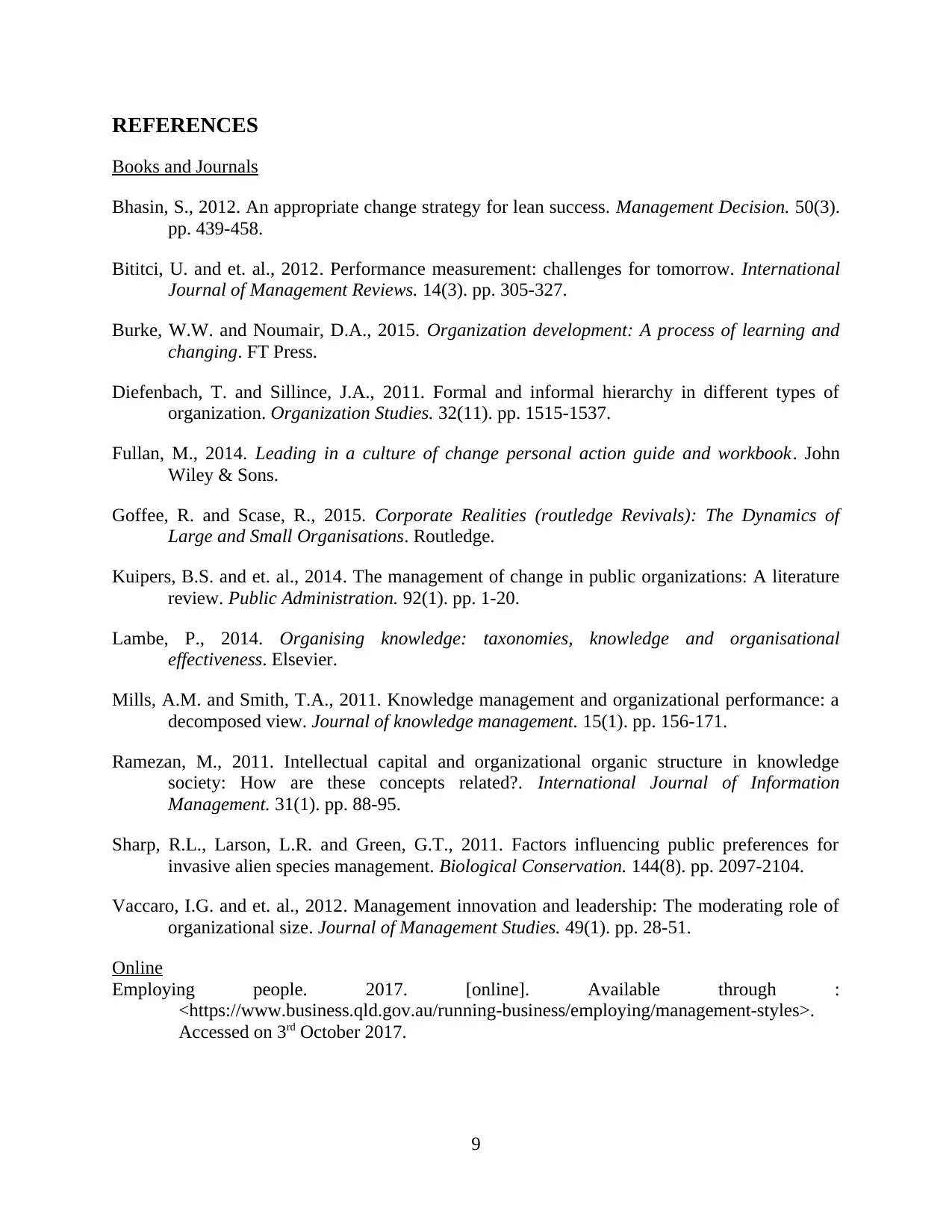
REFERENCES
Books and Journals
Bhasin, S., 2012. An appropriate change strategy for lean success. Management Decision. 50(3).
pp. 439-458.
Bititci, U. and et. al., 2012. Performance measurement: challenges for tomorrow. International
Journal of Management Reviews. 14(3). pp. 305-327.
Burke, W.W. and Noumair, D.A., 2015. Organization development: A process of learning and
changing. FT Press.
Diefenbach, T. and Sillince, J.A., 2011. Formal and informal hierarchy in different types of
organization. Organization Studies. 32(11). pp. 1515-1537.
Fullan, M., 2014. Leading in a culture of change personal action guide and workbook. John
Wiley & Sons.
Goffee, R. and Scase, R., 2015. Corporate Realities (routledge Revivals): The Dynamics of
Large and Small Organisations. Routledge.
Kuipers, B.S. and et. al., 2014. The management of change in public organizations: A literature
review. Public Administration. 92(1). pp. 1-20.
Lambe, P., 2014. Organising knowledge: taxonomies, knowledge and organisational
effectiveness. Elsevier.
Mills, A.M. and Smith, T.A., 2011. Knowledge management and organizational performance: a
decomposed view. Journal of knowledge management. 15(1). pp. 156-171.
Ramezan, M., 2011. Intellectual capital and organizational organic structure in knowledge
society: How are these concepts related?. International Journal of Information
Management. 31(1). pp. 88-95.
Sharp, R.L., Larson, L.R. and Green, G.T., 2011. Factors influencing public preferences for
invasive alien species management. Biological Conservation. 144(8). pp. 2097-2104.
Vaccaro, I.G. and et. al., 2012. Management innovation and leadership: The moderating role of
organizational size. Journal of Management Studies. 49(1). pp. 28-51.
Online
Employing people. 2017. [online]. Available through :
<https://www.business.qld.gov.au/running-business/employing/management-styles>.
Accessed on 3rd October 2017.
9
Books and Journals
Bhasin, S., 2012. An appropriate change strategy for lean success. Management Decision. 50(3).
pp. 439-458.
Bititci, U. and et. al., 2012. Performance measurement: challenges for tomorrow. International
Journal of Management Reviews. 14(3). pp. 305-327.
Burke, W.W. and Noumair, D.A., 2015. Organization development: A process of learning and
changing. FT Press.
Diefenbach, T. and Sillince, J.A., 2011. Formal and informal hierarchy in different types of
organization. Organization Studies. 32(11). pp. 1515-1537.
Fullan, M., 2014. Leading in a culture of change personal action guide and workbook. John
Wiley & Sons.
Goffee, R. and Scase, R., 2015. Corporate Realities (routledge Revivals): The Dynamics of
Large and Small Organisations. Routledge.
Kuipers, B.S. and et. al., 2014. The management of change in public organizations: A literature
review. Public Administration. 92(1). pp. 1-20.
Lambe, P., 2014. Organising knowledge: taxonomies, knowledge and organisational
effectiveness. Elsevier.
Mills, A.M. and Smith, T.A., 2011. Knowledge management and organizational performance: a
decomposed view. Journal of knowledge management. 15(1). pp. 156-171.
Ramezan, M., 2011. Intellectual capital and organizational organic structure in knowledge
society: How are these concepts related?. International Journal of Information
Management. 31(1). pp. 88-95.
Sharp, R.L., Larson, L.R. and Green, G.T., 2011. Factors influencing public preferences for
invasive alien species management. Biological Conservation. 144(8). pp. 2097-2104.
Vaccaro, I.G. and et. al., 2012. Management innovation and leadership: The moderating role of
organizational size. Journal of Management Studies. 49(1). pp. 28-51.
Online
Employing people. 2017. [online]. Available through :
<https://www.business.qld.gov.au/running-business/employing/management-styles>.
Accessed on 3rd October 2017.
9
1 out of 11
Related Documents
Your All-in-One AI-Powered Toolkit for Academic Success.
+13062052269
info@desklib.com
Available 24*7 on WhatsApp / Email
![[object Object]](/_next/static/media/star-bottom.7253800d.svg)
Unlock your academic potential
Copyright © 2020–2025 A2Z Services. All Rights Reserved. Developed and managed by ZUCOL.




